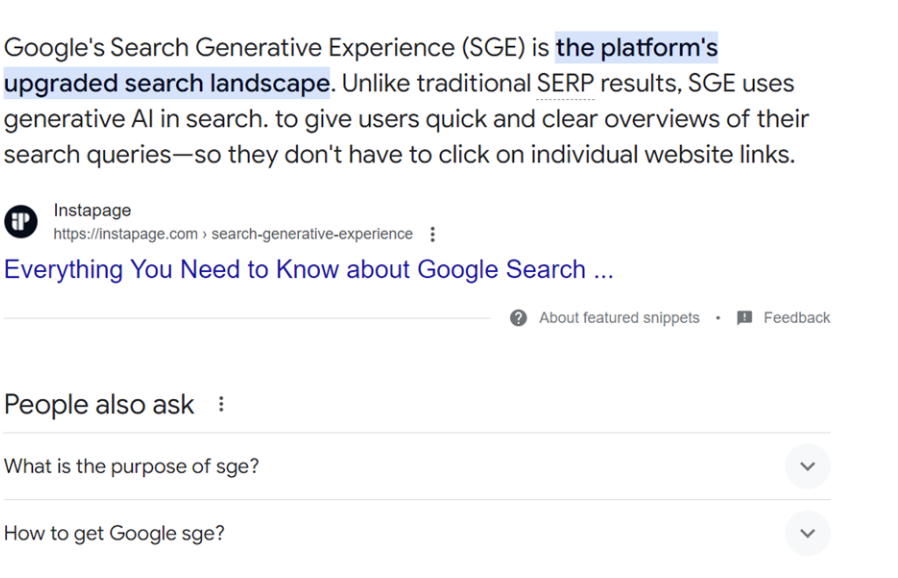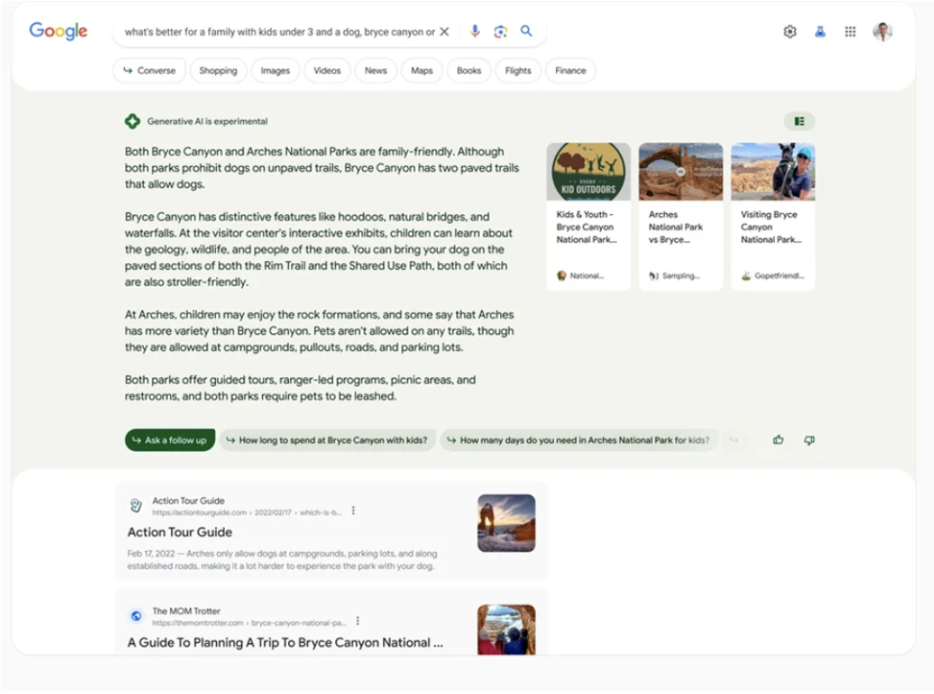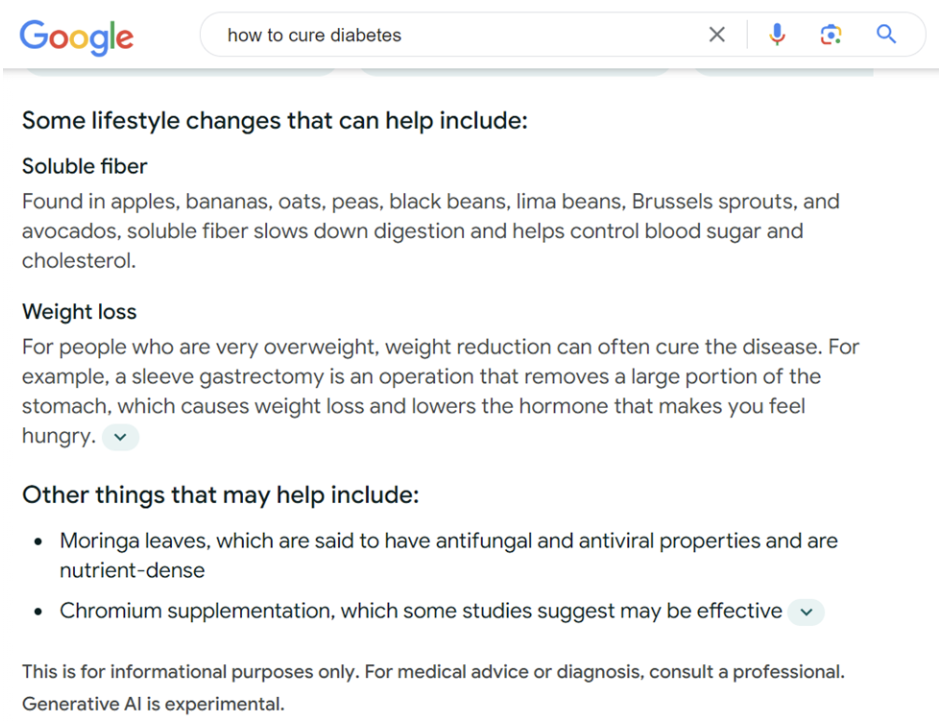The Google Search Generative Experience (SGE) is a new set of search features that rely on generative AI to respond to search engine queries. Marketers have followed Google’s search engine algorithms closely to develop SEO strategies and predict user search behaviors, but generative AI is likely to be quite the marketing shakeup.
This change is helpful for users. They can find information faster and avoid clicking on multiple websites to find what they need. However, brands and news sites may see fewer clicks on their content, more content buried in the search engine results, and even more pressure to create unique, engaging, and targeted content.
As all Google algorithm updates in the past, brands that can rise above—and video offers an opportunity. However, you have to understand how SGE can affect brand video marketing and how to adjust your strategy accordingly.
What Is SGE?
Previously, Google would provide blue links for search user queries. Users would click on those links, generating traffic for the websites. With SGE, the experience shifts with answers to queries at the top of the search results in a concise, conversational format.

Source: Google
SGE search results include an AI-generated summary area to the right of the text that links to “sources” for more information and images. Below that are the sponsored links, organic links, the Featured Snippet, and the “People Also Ask” dropdown.

Source: Google
The bottom line is that users may not need to click on the links if SGE answers their query.
Benefits of SGE
With generative AI capabilities, Google aims to “do the heavy lifting” for users and give them summaries to understand a topic faster, uncover new viewpoints and insights, and get the information they need more quickly.
The example Google uses is the query, “What’s better for a family with kids under three and a dog: Bryce Canyon or Arches?” Under normal search conditions, this one question would require some sleuthing on the user’s part to determine which option is preferred and why to make their own decisions.

Source: Google
With generative AI, the search summary would do some work for the user by suggesting the next steps and offering follow-up questions like “How long would you spend at Bryce Canyon with kids?”
Clicking on those suggestions offers a longer conversation with more specific information and suggestions to explore the topic—with context carried through each additional question.
With shopping, the process will streamline the purchase decisions to help users find the most relevant products with descriptions, current reviews, images, videos, prices, and ratings. The generative AI shopping experience is built on Google’s Shopping Graph, which features over 35 billion product listings that refresh every hour to provide the most reliable results.
Concerns with SGE
It’s clear why Google and users may benefit from SGE, but there are some limitations to be aware of:
Inaccuracy
SGE is still in testing and development. Like other AI models, it has the potential for inaccuracies, which Google is transparent about with a disclaimer that states, “Generative AI is experimental. Info qualify may vary.”
This topic is extremely important for Your Money or Your Life (YMYL), as it can affect a user’s wellbeing, such as health, finance, and safety. If this information is inaccurate, it can be detrimental to users so Google is more particular about the authority and expertise of this content.
For example, if you were to search for something like “how to cure diabetes,” SGE would include general information with a disclaimer that states the search result is not medical advice or diagnosis. It encourages you to consult with a medical provider.

Source: Google
Low Visibility for Paid Search
Google’s search advertising is a revenue source for multiple companies. At this point, Google needs to balance serving the users with SGE without detracting from paid search, which it uses generative AI ads that integrate with organic search results.
With that, generative AI ads may overtake paid search ads, leading to lower visibility overall.
Lack of Transparency
Google may be transparent about the quality of the search results, but the MUM and PaLM 2 learning models are kept under wraps. There’s been a lot of talk about training using various models and fine-tuning with the help of human Raters and evaluations. Still, this lack of transparency can be a problem for users who want to know how AI concludes.
What This Means for Video Marketing
Generative AI has pros and cons for SEO, particularly with videos.
The biggest concern is its impact on traffic. Users who get the information they need from AI-powered summaries do not need to click through to websites. However, there’s an opportunity here for video marketing.
Users could now type in a query and receive written and video results. They often chose the video because it provided digestible information, clear demonstrations, step-by-step instructions, or other values the text couldn’t match.
In this respect, SGE may not trump video results. It’s essentially providing a summary of an article. If a user would otherwise choose a video over an article, they’ll likely still choose a video over the SGE summary because they want the visual content.
Along those lines, basic content that addresses basic queries will decrease, leaving an opportunity to drive higher-quality leads to a website. Google considers SGE a “jumping-off point” for users to explore.
So, there may not be clicks for simple queries like “What time is the Super Bowl?” that would’ve prompted marketers to write 1,000-word articles to attract some visitors. But users will probably need to conduct more in-depth research on certain topics, and when they arrive at your video content, they’ll be more informed and ready to engage.
Keep in mind that SGE won’t be available to all users. Only users who’ve opted to use SGE will get AI-generated results. Others will still use traditional search to find information, so don’t lose that potential traffic by trying to adapt to SGE.
How to Optimize Videos for Generative AI
Here are some tips to optimize your video content with SGE in mind.
Rely on Long-Tail Keywords
SGE encourages users to search for more detailed queries instead of short, simple phrases that can be answered in a sentence or two. For example, instead of “coffee mug,” optimize for a long-tail keyword like “insulated stainless steel coffee mug for travel.”
Create Quality Videos That Align with Search Intent
In many ways, SGE is no different from traditional search results. Google wants to improve the experience by providing users with the most relevant, valuable content, regardless of whether they use traditional search or SGE.
SEO best practices still apply. Create high-quality video content that provides value to the user by addressing common concerns, sharing expert information, and offering helpful tutorials or demonstrations. As always, ensure the information you share is accurate and substantiated by reputable sources.
Your video content must also address search intent—or the reason behind the user’s search query. The types of search intent include:
- Navigational: Users seek out a specific page, such as “Hulu login page.”
- Informational: Users seek specific information, such as “Is Game of Thrones on Hulu?”
- Commercial: Users are researching a possible purchase, such as “Hulu reviews.”
- Transactional: Users want to complete a purchase or other conversion, such as “Hulu free trial signup.”
Once you have the intent, you can look at the search engine results page and consider why the top results have their ranking, if they provide in-depth information, and how you can provide higher-quality content.
This is important for all content, but more so with SGE, because Google links to the content that best aligns with intent. It relies on the first few results in traditional search, so you must aim for those spots.
Implement Structured Data
Structured data, or schema markup, is a coding standard that helps Google categorize and properly display your video content in search results. Adding video schema to your videos, such as a title, description, thumbnail, duration, and upload date, is important to give Google the information it needs to generate rich results.
Use Conversational Language
Conversational language is already a best practice for traditional search and voice search. The same is true for video content competing with SGE. Make sure your video title, tagline, description, and captions are informal and relatable to your audience.
Stay Proactive with SGE
SGE provides generative AI results that can significantly affect video marketing and SEO. This shift may cause a decline in traffic and clicks on sponsored and organic video links.
Still, there’s an opportunity to provide more relevant, valuable content that satisfies the user’s needs in a way that AI summaries can’t.